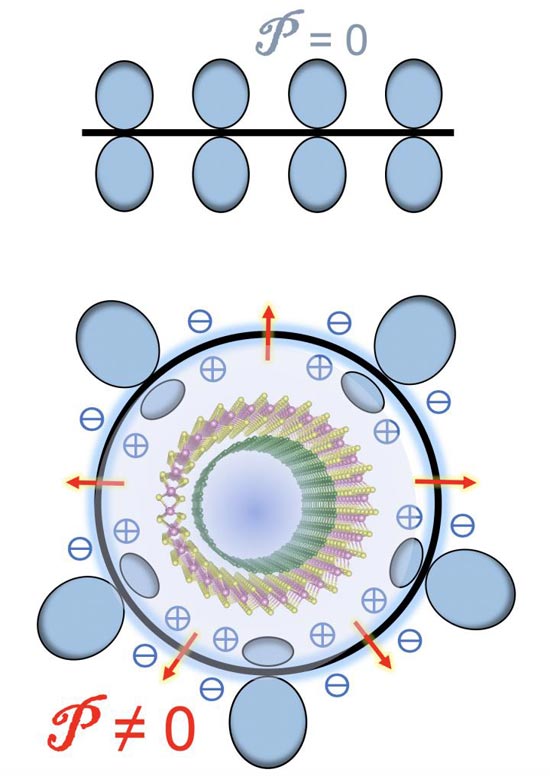
Double-Walled Nanotubes: Boosting Electro-Optical Performance

Rice University theorists have calculated flexoelectric effects in double-walled carbon nanotubes. The electrical potential (P) of atoms on either side of a graphene sheet (top) are identical, but not when the sheet is curved into a nanotube. Double-walled nanotubes (bottom) show unique effects as band gaps in inner and outer tubes are staggered.
Credit: Yakobson Research Group/Rice University
One nanotube could be great for electronics applications, but there's new evidence that two could be tops.
Rice University engineers already knew that size matters when using single-walled carbon nanotubes for their electrical properties. But until now, nobody had studied how electrons act when confronted with the Russian doll-like structure of multiwalled tubes.
The Rice lab of materials theorist Boris Yakobson has now calculated the impact of curvature of semiconducting double-wall carbon nanotubes on their flexoelectric voltage, a measure of electrical imbalance between the nanotube's inner and outer walls.
This affects how suitable nested nanotube pairs may be for nanoelectronics applications, especially photovoltaics.
The theoretical research by Yakobson's Brown School of Engineering group appears in the American Chemical Society journal Nano Letters.
In an 2002 study, Yakobson and his Rice colleagues had revealed how charge transfer, the difference between positive and negative poles that allows voltage to exist between one and the other, scales linearly to the curvature of the nanotube wall.
The width of the tube dictates curvature, and the lab found that the thinner the nanotube (and thus larger the curvature), the greater the potential voltage.
When carbon atoms form flat graphene, the charge density of the atoms on either side of the plane are identical, Yakobson said. Curving the graphene sheet into a tube breaks that symmetry, changing the balance.
That creates a flexoelectric local dipole in the direction of, and proportional to, the curvature, according to the researchers, who noted that the flexoelectricity of 2D carbon “is a remarkable but also fairly subtle effect.”
But more than one wall greatly complicates the balance, altering the distribution of electrons. In double-walled nanotubes, the curvature of the inner and outer tubes differ, giving each a distinct band gap. Additionally, the models showed the flexoelectric voltage of the outer wall shifts the band gap of the inner wall, creating a staggered band alignment in the nested system.
“The novelty is that the inserted tube, the 'baby' (inside) matryoshka has all of its quantum energy levels shifted because of the voltage created by exterior nanotube,” Yakobson said. The interplay of different curvatures, he said, causes a straddling-to-staggered band gap transition that takes place at an estimated critical diameter of about 2.4 nanometers.
“This is a huge advantage for solar cells, essentially a prerequisite for separating positive and negative charges to create a current,” Yakobson said. “When light is absorbed, an electron always jumps from the top of an occupied valence band (leaving a 'plus' hole behind) to the lowest state of empty conductance band.
“But in a staggered configuration they happen to be in different tubes, or layers,” he said. “The 'plus' and 'minus' get separated between the tubes and can flow away by generating current in a circuit.”
The team's calculations also showed that modifying the nanotubes' surfaces with either positive or negative atoms could create “substantial voltages of either sign” up to three volts. “Although functionalization could strongly perturb the electronic properties of nanotubes, it may be a very powerful way of inducing voltage for certain applications,” the researchers wrote.
The team suggested its findings may apply to other types of nanotubes, including boron nitride and molybdenum disulfide, on their own or as hybrids with carbon nanotubes.
###
Rice alumnus Vasilii Artyukhov, now at Quantlab Financial, Houston, is lead author of the paper. Co-authors are Rice graduate student Sunny Gupta and research scientist Alex Kutana. Yakobson is the Karl F. Hasselmann Professor of Materials Science and NanoEngineering and a professor of chemistry at Rice.
The Army Research Office and the Robert Welch Foundation supported the research, with computational support from the Department of Defense High Performance Computing Modernization Program and the Department of Energy Office of Science.
Read the abstract at https:/
This news release can be found online at https:/
Follow Rice News and Media Relations via Twitter @RiceUNews.
Related materials:
Curvature-induced polarization in carbon nanoshells: https:/
Yakobson Research Group: https:/
Rice Department of Materials Science and Nanoengineering: https:/
George R. Brown School of Engineering: https:/
Image for download:
https:/
Rice University theorists have calculated flexoelectric effects in double-walled carbon nanotubes. The electrical potential (P) of atoms on either side of a graphene sheet (top) are identical, but not when the sheet is curved into a nanotube. Double-walled nanotubes (bottom) show unique effects as band gaps in inner and outer tubes are staggered. (Credit: Yakobson Research Group/Rice University)
Located on a 300-acre forested campus in Houston, Rice University is consistently ranked among the nation's top 20 universities by U.S. News & World Report. Rice has highly respected schools of Architecture, Business, Continuing Studies, Engineering, Humanities, Music, Natural Sciences and Social Sciences and is home to the Baker Institute for Public Policy. With 3,962 undergraduates and 3,027 graduate students, Rice's undergraduate student-to-faculty ratio is just under 6-to-1. Its residential college system builds close-knit communities and lifelong friendships, just one reason why Rice is ranked No. 1 for lots of race/class interaction and No. 4 for quality of life by the Princeton Review. Rice is also rated as a best value among private universities by Kiplinger's Personal Finance.
Jeff Falk
713-348-6775
jfalk@rice.edu
Mike Williams
713-348-6728
mikewilliams@rice.edu












